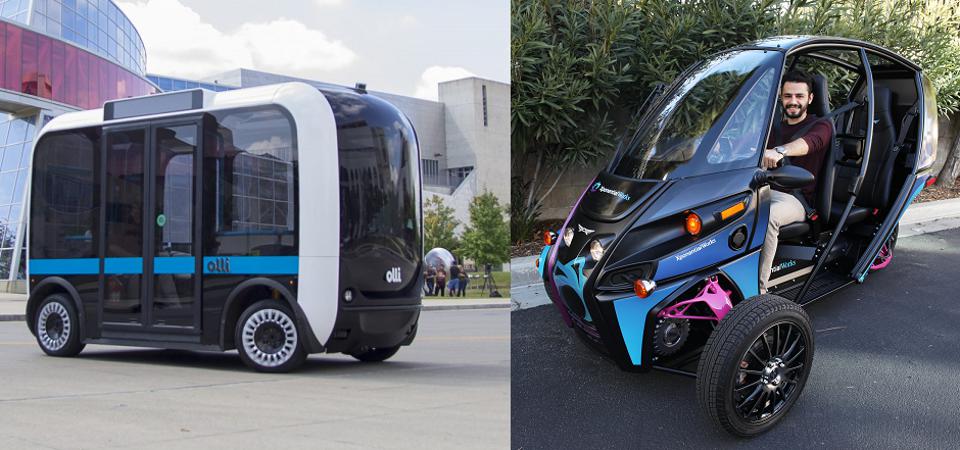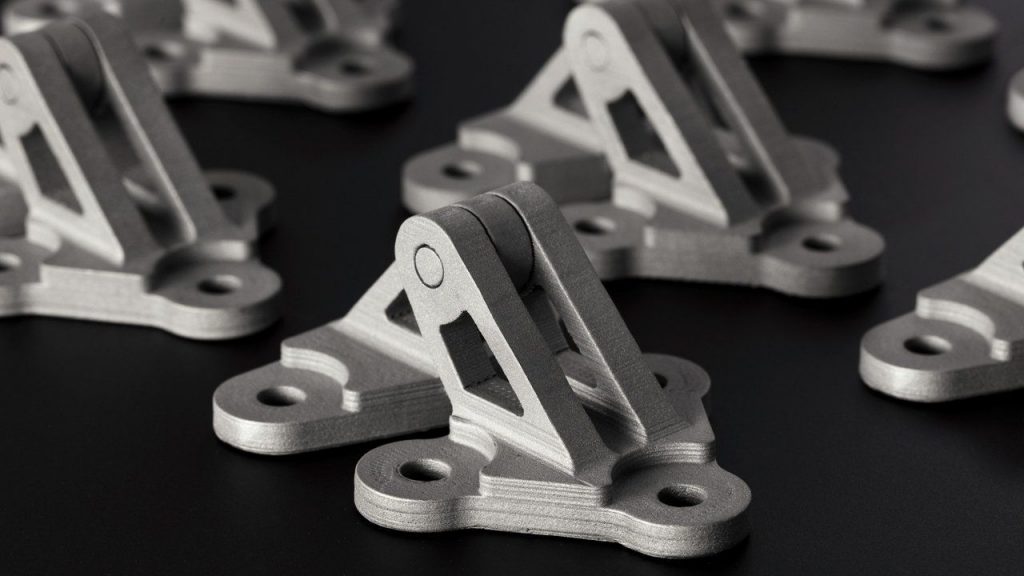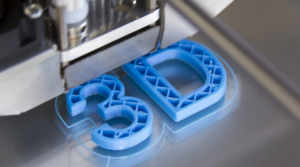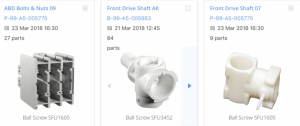New trends in autonomous vehicles, electric cars and mass customisation are forcing automakers and suppliers to adapt. To stay relevant in the age of Industry 4.0, automotive companies are accelerating the adoption of 3D printing technologies.
Today, 3D printing, or Additive Manufacturing (AM), is used across many stages of car manufacturing, from prototyping and tooling fabrication to spare and end-part production, enabling automakers to stay agile and innovative.
As 3D printing gets a stronger foothold in the automotive industry, we explore four exciting trends shaping the future of the technology in the sector.
1. 3D Printing Will Power the Electrification of Vehicles

Electric shuttle Olli (left) and Arcimoto’s FUV (right) feature 3D-printed components. The use of 3D printing helped to reduce the weight of the vehicles. [Image credits: Local Motors, Arcimoto]
A recent survey by Jabil states that 48 per cent of automakers aim to be market leaders in electric vehicles. This increasing trend for electrification of vehicles plays into the growing use of AM in automotive.
As the industry moves away from the internal combustion engines toward electric vehicles, 3D printing rises as a solution that can speed up development and radically change the way we look at the design of car components.
The latter is possible thanks to the lightweighting capabilities of new design tools, like generative design, and the flexibility of AM to bring advanced designs to life.
In an interview with Additive Manufacturing Media, Kevin Quinn, General Motors’ director of additive design and manufacturing, says that it’s only a matter of time before generative design and AM become the primary technologies driving lighter parts for electric cars.
But why is lightweighting so important?
Reducing weight has long been a goal in vehicles powered by combustion engines to aid in decreasing fuel consumption and emissions. In electric vehicles, reduced weight still plays a role in lowering energy consumption and thus increasing driving range with a given battery. But there’s another consideration.
The heavier the vehicle, the more battery capacity it needs to achieve established range and performance goals. But batteries are heavy, compared to other vehicle components, so adding battery capacity tends to increase vehicle weight disproportionately.
It’s a vicious cycle that means weight reduction – both overall vehicle weight and that of its components – is critical in an EV vehicle.
As of 2020, several EV projects are using 3D printing in development and production. One example is Local Motors’ Olli, a 3D-printed, autonomous electric shuttle designed for local, low-speed transportation.
The shuttle has been designed primarily for use in urban centres in cities, business and university campuses and hospitals.
So how has the company achieved this?
Local Motors used some of the world’s largest 3D printers – ORNL’s Big Area Additive Manufacturing (BAAM) and Thermwood’s Large Scale Additive Manufacturing (LSAM) machines – to produce most of Olli’s components, including the roof and lower body of the vehicle.
The autonomous shuttle, which is currently involved in trials in 13 locations around the world, marks a substantial milestone in using 3D printing for EV production.
Local Motors is not the only company pursuing 3D-printed EVs, though. Arcimoto, a US manufacturer of sustainable vehicles, is producing Fun Utility Vehicles (FUVs), which feature lightweight 3D-printed components, developed in partnership with XponentialWorks.
The parts, including a rear swing arm, knuckle, upper control arm and a brake pedal, were redesigned for 3D printing using ParaMatters’ generative design tool, achieving weight savings of between 34 and 49 per cent.
With the parts redesigned thus far, the companies have delivered 120 of the 200-pound weight reduction target and plan to reach the final goal in the coming months.
As the EV industry continues to figure out how to best leverage 3D printing, the next decade will be pivotal to accelerating the use of the technology for sustainable vehicles.
2. Integrating AM in automotive series production

3. Collaboration drives AM industrialisation in automotive
Companies and research institutions, alike, are working hard to translate 3D printing into industrialised, highly automated production processes for car manufacturing.
Increased collaboration is particularly evident in the number of projects launched recently.
One such project is the Industrialization and Digitalization of Additive Manufacturing (IDAM) project from Germany, launched last year.
Twelve project partners plan to create AM production lines capable of producing at least 50,000 components per year in common parts production and more than 10,000 individual and spare parts under the highest quality and cost pressure.
Besides, the unit costs of the 3D-printed metal components are to be more than halved, according to the project.
Coordinated by the BMW Group, the IDAM project will run for the next two years, helping to establish metal 3D printing sustainably in production.
In addition to metal 3D printing, the industry also seeks to advance polymer AM for car manufacturing. In this regard, POLYLINE project marks the milestone for automotive polymer 3D printing.
Launched earlier this year, the POLYLINE project aims to overcome existing challenges in integrating AM into automotive production lines. For example, the project participants will work on developing new standards and creating solutions to increase automation on the production floor.
Looking at horizontal integration, the project will work on establishing digital data workflows, to achieve greater efficiency across production processes and supply chains.
Both projects are Germany-based, which is not surprising, given that German automakers have invested the most in developing AM for final part production to date.
4. 3D-printed electronics for connected cars

Electronics 3D printing works by jetting conductive and insulating inks on the printing surface in lines as thin as few microns. UV light is then applied to solidify the inks. [Image credit: Neotech AMT]
As the world enters a new era of connected vehicles, the number of electronic devices, like sensors and antennae within the vehicle, is increasing. With this increase comes a greater need for designing and producing smaller, more complex electronics.
3D printing for electronics is creating new ways of producing smart components to network vehicles and gather automotive data.
Let’s take sensors as an example. To enable vehicles to gather environmental and car performance data, you’ll need sensors with wireless capabilities, customised form factors and even non-planar geometries.
Traditionally, such sensors are fabricated separately from the vehicle and need first to be assembled and then shipped to the manufacturer to be finally installed into a component.
The advancements in AM systems for electronics unlock the opportunity to embed these sensors directly into mechanical components and the structure of vehicles. This approach can lead to higher reliability and longer lifetime compared to conventionally assembled sensors.
Furthermore, electronic 3D printing can reduce the costs and development time for creating these sensors.
Different buttons found in a car could be one application to benefit from 3D-printed sensors. Researchers at the Institute of Systems and Robotics in Portugal are developing approaches to replace physical buttons with 3D-printed touch sensors.
Neotech AMT GmbH, a developer of 3D printing electronics hardware, sees another potential application of 3D-printed electronics, namely heater patterns for car interiors. 3D printing of heater patterns can reduce their weight, parts count and manual assembly steps.
Despite all the benefits, 3D-printed electronic components for cars are still some time away. But with many automakers adopting 3D printing for metal and plastic car parts, the greater use of 3D printing for lighter, more complex electronic components is sure to follow.
3D Printing in Automotive: On the Brink of Change
As cars are becoming smarter and more autonomous, automakers and suppliers find themselves on the cusp of revolutionary changes. These changes are also fuelling the growing use of 3D printing in automotive.
3D printing helps companies become more flexible in production and develop better car components that would be impossible with traditional processes.
Weaving 3D printing technologies into automotive production has also become a trend in its own right. Automakers ink strategic partnerships with AM companies and initiate collaborative projects, to industrialise AM.
While the results of these efforts are yet to be demonstrated, their scope and vision signal that the future of 3D printing in the automotive industry will be bright.



